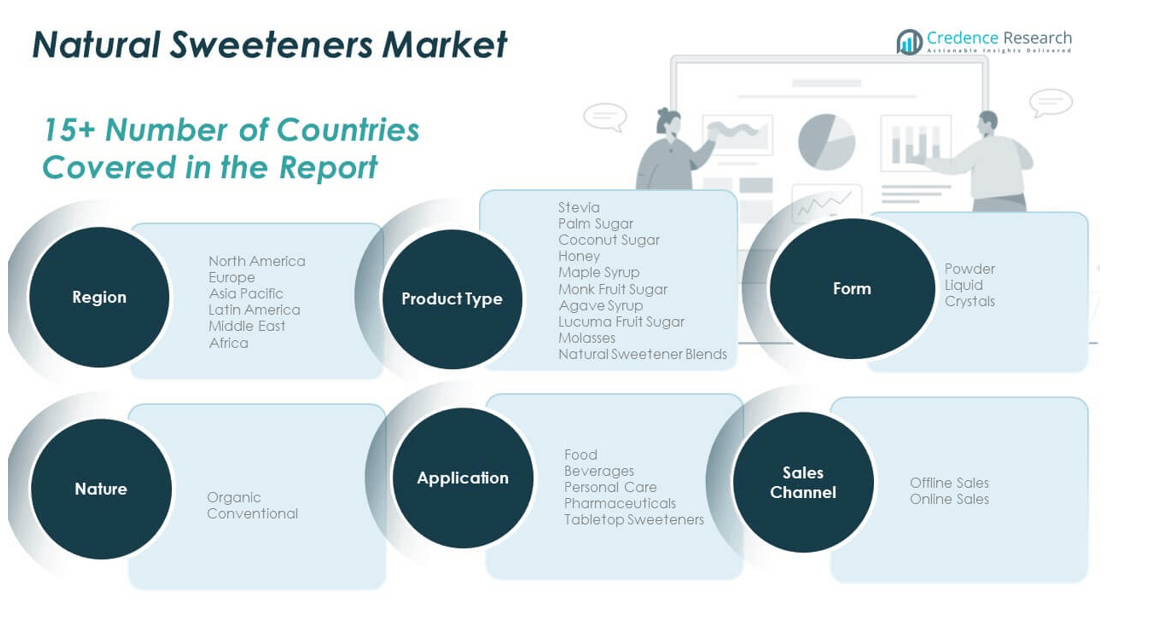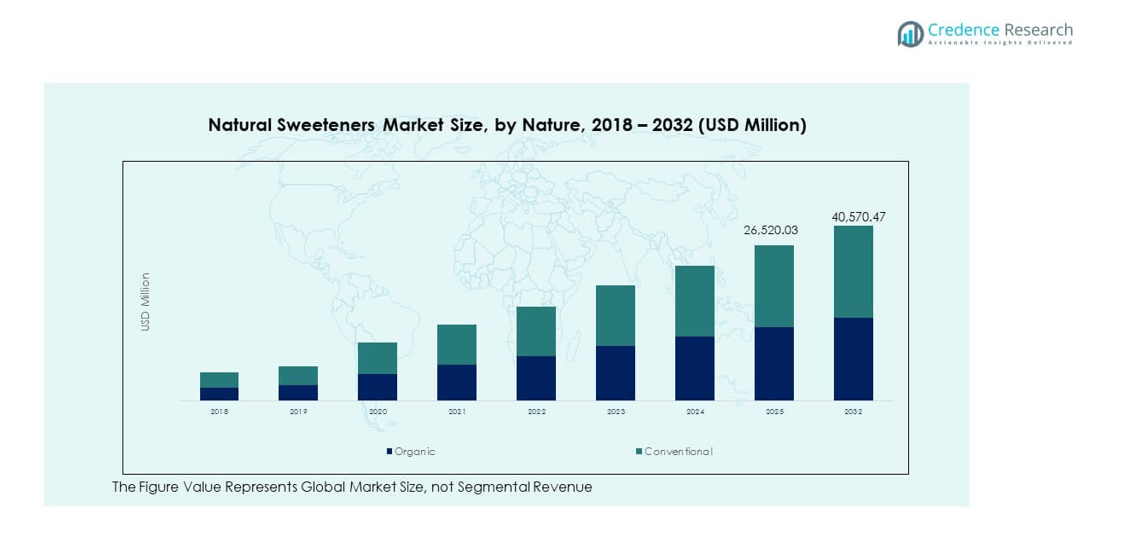CHAPTER NO. 1 : GENESIS OF THE MARKET
1.1 Market Prelude – Introduction & Scope
1.2 The Big Picture – Objectives & Vision
1.3 Strategic Edge – Unique Value Proposition
1.4 Stakeholder Compass – Key Beneficiaries
CHAPTER NO. 2 : EXECUTIVE LENS
2.1 Pulse of the Industry – Market Snapshot
2.2 Growth Arc – Revenue Projections (USD Million)
2.3. Premium Insights – Based on Primary Interviews
CHAPTER NO. 3 : NATURAL SWEETENERS MARKET FORCES & INDUSTRY PULSE
3.1 Foundations of Change – Market Overview
3.2 Catalysts of Expansion – Key Market Drivers
3.2.1 Momentum Boosters – Growth Triggers
3.2.2 Innovation Fuel – Disruptive Technologies
3.3 Headwinds & Crosswinds – Market Restraints
3.3.1 Regulatory Tides – Compliance Challenges
3.3.2 Economic Frictions – Inflationary Pressures
3.4 Untapped Horizons – Growth Potential & Opportunities
3.5 Strategic Navigation – Industry Frameworks
3.5.1 Market Equilibrium – Porter’s Five Forces
3.5.2 Ecosystem Dynamics – Value Chain Analysis
3.5.3 Macro Forces – PESTEL Breakdown
3.6 Price Trend Analysis
3.6.1 Regional Price Trend
3.6.2 Price Trend by product
CHAPTER NO. 4 : KEY INVESTMENT EPICENTER
4.1 Regional Goldmines – High-Growth Geographies
4.2 Product Frontiers – Lucrative Product Categories
4.3 Application Sweet Spots – Emerging Demand Segments
CHAPTER NO. 5: REVENUE TRAJECTORY & WEALTH MAPPING
5.1 Momentum Metrics – Forecast & Growth Curves
5.2 Regional Revenue Footprint – Market Share Insights
5.3 Segmental Wealth Flow – Product Type & Application Revenue
CHAPTER NO. 6 : TRADE & COMMERCE ANALYSIS
6.1. Import Analysis by Region
6.1.1. Global Natural Sweeteners Market Import Revenue By Region
6.2. Export Analysis by Region
6.2.1. Global Natural Sweeteners Market Export Revenue By Region
CHAPTER NO. 7 : COMPETITION ANALYSIS
7.1. Company Market Share Analysis
7.1.1. Global Natural Sweeteners Market: Company Market Share
7.2. Global Natural Sweeteners Market Company Revenue Market Share
7.3. Strategic Developments
7.3.1. Acquisitions & Mergers
7.3.2. New Product Launch
7.3.3. Regional Expansion
7.4. Competitive Dashboard
7.5. Company Assessment Metrics, 2024
CHAPTER NO. 8 : NATURAL SWEETENERS MARKET – BY PRODUCT TYPE SEGMENT ANALYSIS
8.1. Natural Sweeteners Market Overview by Product Type Segment
8.1.1. Natural Sweeteners Market Revenue Share By Product Type
8.2. Stevia
8.3 Palm Sugar
8.4. Coconut Sugar
8.5. Honey
8.6. Maple Syrup
8.7. Monk Fruit Sugar
8.8. Agave Syrup
8.9. Lucuma Fruit Sugar
8.10. Molasses
8.11. Natural Sweetener Blends
CHAPTER NO. 9 : NATURAL SWEETENERS MARKET – BY APPLICATION SEGMENT ANALYSIS
9.1. Natural Sweeteners Market Overview by Application Segment
9.1.1. Natural Sweeteners Market Revenue Share By Application
9.2. Food
9.3. Beverages
9.4. Personal Care
9.5. Pharmaceuticals
9.6. Tabletop Sweeteners
CHAPTER NO. 10 : NATURAL SWEETENERS MARKET – BY FORM SEGMENT ANALYSIS
10.1. Natural Sweeteners Market Overview by Form Segment
10.1.1. Natural Sweeteners Market Revenue Share By Form
10.2. Powder
10.3. Liquid
10.4. Crystals
CHAPTER NO. 11 : NATURAL SWEETENERS MARKET – BY NATURE SEGMENT ANALYSIS
11.1. Natural Sweeteners Market Overview by Nature Segment
11.1.1. Natural Sweeteners Market Revenue Share By Nature
11.2. Organic
11.3. Conventional
CHAPTER NO. 12 : NATURAL SWEETENERS MARKET – BY SALES CHANNEL SEGMENT ANALYSIS
12.1. Natural Sweeteners Market Overview by Sales Channel Segment
12.1.1. Natural Sweeteners Market Revenue Share By Sales Channel
12.2. Offline Sales
12.3. Online Sales
CHAPTER NO. 13 : NATURAL SWEETENERS MARKET – REGIONAL ANALYSIS
13.1. Natural Sweeteners Market Overview by Region Segment
13.1.1. Global Natural Sweeteners Market Revenue Share By Region
13.1.2. Regions
13.1.3. Global Natural Sweeteners Market Revenue By Region
13.1.4. Product Type
13.1.5. Global Natural Sweeteners Market Revenue By Product Type
13.1.6. Application
13.1.7. Global Natural Sweeteners Market Revenue By Application
13.1.8. Form
13.1.9. Global Natural Sweeteners Market Revenue By Form
13.1.10. Nature
13.1.12. Global Natural Sweeteners Market Revenue By Nature
13.1.13. Sales Channel
13.1.14. Global Natural Sweeteners Market Revenue By Sales Channel
CHAPTER NO. 14 : NORTH AMERICA NATURAL SWEETENERS MARKET – COUNTRY ANALYSIS
14.1. North America Natural Sweeteners Market Overview by Country Segment
14.1.1. North America Natural Sweeteners Market Revenue Share By Region
14.2. North America
14.2.1. North America Natural Sweeteners Market Revenue By Country
14.2.2. Product Type
14.2.3. North America Natural Sweeteners Market Revenue By Product Type
14.2.4. Application
14.2.5. North America Natural Sweeteners Market Revenue By Application
14.2.6. Form
14.2.7. North America Natural Sweeteners Market Revenue By Form
14.2.8.Nature
14.2.9. North America Natural Sweeteners Market Revenue By Nature
14.2.10. Sales Channel
14.2.11. North America Natural Sweeteners Market Revenue By Sales Channel
14.3. U.S.
14.4. Canada
14.5. Mexico
CHAPTER NO. 15 : EUROPE NATURAL SWEETENERS MARKET – COUNTRY ANALYSIS
15.1. Europe Natural Sweeteners Market Overview by Country Segment
15.1.1. Europe Natural Sweeteners Market Revenue Share By Region
15.2. Europe
15.2.1. Europe Natural Sweeteners Market Revenue By Country
15.2.2. Product Type
15.2.3. Europe Natural Sweeteners Market Revenue By Product Type
15.2.4. Application
15.2.5. Europe Natural Sweeteners Market Revenue By Application
15.2.6. Form
15.2.7. Europe Natural Sweeteners Market Revenue By Form
15.2.8.Nature
15.2.9. Europe Natural Sweeteners Market Revenue By Nature
15.2.10. Sales Channel
15.2.11. Europe Natural Sweeteners Market Revenue By Sales Channel
15.3. UK
15.4. France
15.5. Germany
15.6. Italy
15.7. Spain
15.8. Russia
15.9. Rest of Europe
CHAPTER NO. 16 : ASIA PACIFIC NATURAL SWEETENERS MARKET – COUNTRY ANALYSIS
16.1. Asia Pacific Natural Sweeteners Market Overview by Country Segment
16.1.1. Asia Pacific Natural Sweeteners Market Revenue Share By Region
16.2. Asia Pacific
16.2.1. Asia Pacific Natural Sweeteners Market Revenue By Country
16.2.2. Product Type
16.2.3. Asia Pacific Natural Sweeteners Market Revenue By Product Type
16.2.4. Application
16.2.5. Asia Pacific Natural Sweeteners Market Revenue By Application
16.2.6. Form
16.2.7. Asia Pacific Natural Sweeteners Market Revenue By Form
16.2.8.Nature
16.2.9. Asia Pacific Natural Sweeteners Market Revenue By Nature
16.2.10. Sales Channel
16.2.11. Asia Pacific Natural Sweeteners Market Revenue By Sales Channel
16.3. China
16.4. Japan
16.5. South Korea
16.6. India
16.7. Australia
16.8. Southeast Asia
16.9. Rest of Asia Pacific
CHAPTER NO. 17 : LATIN AMERICA NATURAL SWEETENERS MARKET – COUNTRY ANALYSIS
17.1. Latin America Natural Sweeteners Market Overview by Country Segment
17.1.1. Latin America Natural Sweeteners Market Revenue Share By Region
17.2. Latin America
17.2.1. Latin America Natural Sweeteners Market Revenue By Country
17.2.2. Product Type
17.2.3. Latin America Natural Sweeteners Market Revenue By Product Type
17.2.4. Application
17.2.5. Latin America Natural Sweeteners Market Revenue By Application
17.2.6. Form
17.2.7. Latin America Natural Sweeteners Market Revenue By Form
17.2.8.Nature
17.2.9. Latin America Natural Sweeteners Market Revenue By Nature
17.2.10. Sales Channel
17.2.11. Latin America Natural Sweeteners Market Revenue By Sales Channel
17.3. Brazil
17.4. Argentina
17.5. Rest of Latin America
CHAPTER NO. 18 : MIDDLE EAST NATURAL SWEETENERS MARKET – COUNTRY ANALYSIS
18.1. Middle East Natural Sweeteners Market Overview by Country Segment
18.1.1. Middle East Natural Sweeteners Market Revenue Share By Region
18.2. Middle East
18.2.1. Middle East Natural Sweeteners Market Revenue By Country
18.2.2. Product Type
18.2.3. Middle East Natural Sweeteners Market Revenue By Product Type
18.2.4. Application
18.2.5. Middle East Natural Sweeteners Market Revenue By Application
18.2.6. Form
18.2.7. Middle East Natural Sweeteners Market Revenue By Form
18.2.8. Nature
18.2.9. Middle East Natural Sweeteners Market Revenue By Nature
18.2.10. Sales Channel
18.2.11. Middle East Natural Sweeteners Market Revenue By Sales Channel
18.3. GCC Countries
18.4. Israel
18.5. Turkey
18.6. Rest of Middle East
CHAPTER NO. 19 : AFRICA NATURAL SWEETENERS MARKET – COUNTRY ANALYSIS
19.1. Africa Natural Sweeteners Market Overview by Country Segment
19.1.1. Africa Natural Sweeteners Market Revenue Share By Region
19.2. Africa
19.2.1. Africa Natural Sweeteners Market Revenue By Country
19.2.2. Product Type
19.2.3. Africa Natural Sweeteners Market Revenue By Product Type
19.2.4. Application
19.2.5. Africa Natural Sweeteners Market Revenue By Application
19.2.6. Form
19.2.7. Africa Natural Sweeteners Market Revenue By Form
19.2.8.Nature
19.2.9. Africa Natural Sweeteners Market Revenue By Nature
19.2.10. Sales Channel
19.2.11. Africa Natural Sweeteners Market Revenue By Sales Channel
19.3. South Africa
19.4. Egypt
19.5. Rest of Africa
CHAPTER NO. 20 : COMPANY PROFILES
20.1. DuPont (US)
20.1.1. Company Overview
20.1.2. Product Portfolio
20.1.3. Financial Overview
20.1.4.Recent Developments
20.1.5. Growth Strategy
20.1.6. SWOT Analysis
20.2. ADM (Archer Daniels Midland) (US)
20.3. Tate & Lyle PLC (UK)
20.4. Cargill (US)
20.5. Ingredion Incorporated (US)
20.6. Roquette Frères (France)
20.7. FoodChem International Corporation (China)
20.8. PureCircle Ltd (US)
20.9. MacAndrews & Forbes Holdings Inc (Merisant) (US)
20.10. Ecogreen Oleochemicals (Indonesia)
20.11. Pyure Brands LLC (US)
20.12. Stevia Hub India (India)
20.13. Suminter India Organics (India)
20.14. Stevia Biotech Pvt Ltd (India)
20.15. The Real Stevia Company (Sweden)
20.16. Sweetly Stevia USA (UK)
20.17. XiliNat (Mexico)
20.18. Fooditive B.V. (Netherlands)
20.19. Saganà Association (Switzerland)
20.20. Hearthside Food Solutions LLC (US)






